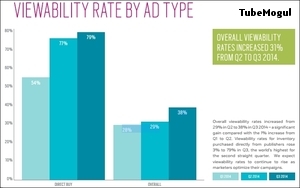Video Viewability Rising As Marketers Turn To 'Programmatic Direct' Technologies
- by Tyler Loechner @mp_tyler, December 11, 2014
 Marketers are still struggling to get even half of their digital ads seen, but video viewability rates are steadily rising. Overall video viewability rates increased to 38% in the third
quarter of 2014, up from 29% in the second quarter and 28% to begin the year.
Marketers are still struggling to get even half of their digital ads seen, but video viewability rates are steadily rising. Overall video viewability rates increased to 38% in the third
quarter of 2014, up from 29% in the second quarter and 28% to begin the year.
Video ads bought directly from publishers were 79% viewable last quarter, up slightly from 77% in the second quarter.
However, that’s a large increase from the 54% mark that direct buy deals had in the first quarter of 2014 and significantly better than the 38% rate that all video ads had in the third quarter.
This may be one reason that marketers continue to rapidly turn toward private marketplaces and “programmatic direct” technologies, which allow ad buyers to work directly with publishers while automating processes such as RFPs and I/Os.
“The amount of inventory purchased directly from publishers through automated channels increased 193%” in the third quarter of 2014 compared to the second quarter, per TubeMogul’s latest quarterly research report. Impressions purchased on a “programmatic direct” basis via TubeMogul’s BrandAccess -- the programmatic ad firm’s private marketplace service -- have increased 4,687% since the fourth quarter of 2013.
“The growth really demonstrates that both advertisers and publishers are making their direct buys programmatic,” a TubeMogul representative said.
The amount of “premium” inventory entering the programmatic ecosystem has increased as well. TubeMogul notes that inventory available for programmatic buying from comScore Top 100 publishers increased 74% quarter-over-quarter and has increased 499% since the fourth quarter of 2013.
Similarly, marketers are trading more mobile video inventory via programmatic. TubeMogul reports that there were 74% more auctions in the U.S. for mobile video inventory in the third quarter of 2014 compared to the second quarter. The amount of mobile video inventory has increased 659% since the fourth quarter of 2013.
TubeMogul notes that despite the rapid rise in mobile video inventory available for programmatic buying, CPMs have only decreased 11% — down to $11.19 — since the fourth quarter of 2013. TubeMogul theorizes that “likely reflect[s] high demand.”



One thing that puzzles me about this viewability thing, aside from the obvious definitional issues, is how do advertisers and/or their agency "trading desks" police their buys? How many publishers supply valid and credible reports indicating their viewability performance on a buy by buy basis? And what happens when the ads aren't viewable? Are "make goods" offered until the promised numbers of "viewable" impressions are attained? If so, how are these adjustments monitored? Just asking.
Ed- Generally speaking tags are inserted and tracked through 3rd party ad servers like Vindico and Telemetry along with comScore tagging for demo purposes. There are others but I just used those as reference. It really isn't about "publisher" reports as much as the the 3rd party tracking that validates the delivery. Your question on what happens when ads aren't viewable is being asked daily and it's one of the reasons that brands are requiring more accountability. It is getting better and will continue to get better as tracking becomes more accurate and both DSP's and SSP's become more accountable to brands. On the monitoring adjustment question, it's a matter of negotiating impression makegoods. No different then any medium.
Thanks, Jon. That makes sense to me.